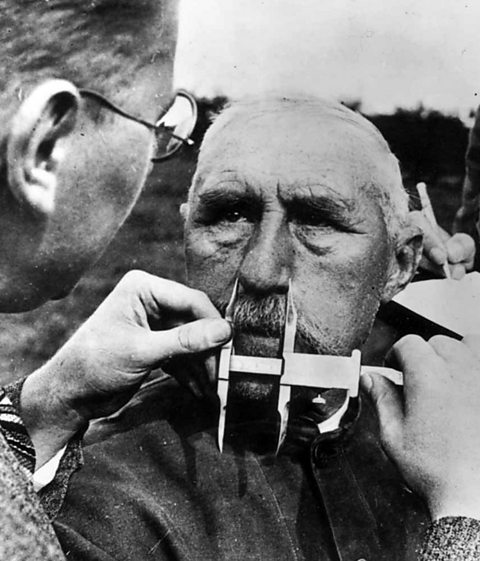The persecution of minorities
Hitler and the Nazis had firm views on race. They believed that certain groups were inferior and were a threat to the purity of the AryanA person of European descent - not Jewish - often with blond hair and blue eyes. The Nazis viewed Aryans as the superior human race. race. There were many groups who were targeted for persecution, including Slavs (Eastern Europeans), GypsyA member of a travelling community usually with dark skin and hair., homosexuals and the disabled - but none more so than the Jews.
Nazi racial beliefs

The Nazisâ racial philosophy taught that Aryans were the master race and that some races were âuntermenschâ (sub-human). Many Nazi scientists at this time believed in eugenics, the idea that people with disabilities or social problems were degeneratesImmoral or inferior people. whose genes needed to be eliminated from the human bloodline. The Nazis pursued eugenics policies vigorously.
Policy of persecution
- Sterilisation - In order to keep the Aryan race pure, many groups were prevented from reproducing. The mentally and physically disabled, including the deaf, were sterilised, as were people with hereditaryPassed on from parents to offspring through genes. diseases.
- Euthanasia - Between 1939 and 1941 over 100,000 physically and mentally disabled Germans were killed in secret, without the consent of their families. Victims were often gassed - a technique that was later used in the death camps of the Holocaust.
- Concentration camps - Homosexuals, prostitutes, Jehovah's Witnesses, gypsies, alcoholics, pacifistSomeone who is completely opposed to any kind of violence and will not participate in any aspect of war., beggars, hooligans and criminals were often rounded up and sent away to camps. During World War Two 85 per cent of Germany's gypsies died in these camps.
The Nazisâ persecution of the Jews
The group most heavily targeted for persecution by the Nazis were the Jews of Germany. The outbreak of World War Two brought the horror of mass killings and the Final Solution, but the period 1933 saw a gradual increase in persecution, reaching a turning point during Kristallnacht in November 1938:
1933
- Nazis organised a boycott of Jewish businesses.
- Books by Jewish authors were publicly burnt.
- Jewish civil servants, lawyers and teachers were sacked.
- Race science lessons were introduced, teaching that Jews were sub-human.
1935
The Nuremberg LawsThe Nuremberg Laws were anti-Semitic laws in Nazi Germany. formalised anti-Semitism into the Nazi state by:
- Stripping Jews of German citizenshipA person's nationality.
- Outlawing marriage and sexual relations between Jews and Germans.
- Taking away from Jews all civil and political rights.
1938
- Jews could not be doctors.
- Jews had to add the name Israel (men) or Sarah (women) to their name.
- Jewish children were forbidden to go to school.
- Kristallnacht - 9 November. The SS organised attacks on Jewish homes, businesses and synagogues in retaliation for the assassination of the German ambassador to France by a Jew.
1939
- Jews were forbidden to own a business, or even a radio
By the outbreak of World War Two in September 1939, the Jews were stateless, their employment options in Germany were severely restricted and they feared for their safety.
More guides on this topic
- Weimar Germany overview - Edexcel
- The Weimar Republic 1918-1929 - Edexcel
- A History of the Weimar Republic quiz
- Hitler's rise to power, 1919-1933 - Edexcel
- Rise of the Nazi Party quiz
- Nazi control and dictatorship 1933-1939 - Edexcel
- Creation of a dictatorship quiz
- Women, minorities and living standards in Nazi Germany quiz
- Weimar Germany - exam preparation - Edexcel